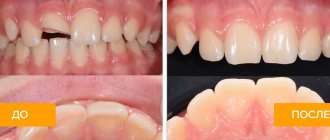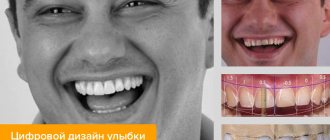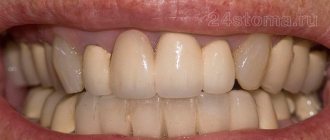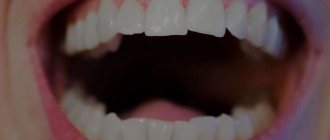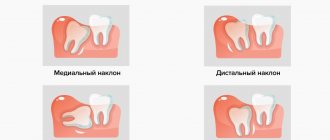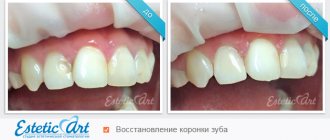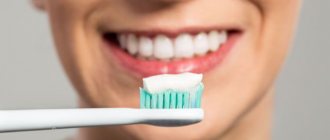The structure of the tooth is a combination of the outer enamel layer, dentin, and the pulp chamber, which contains nerve and vascular endings. In cases where pathological processes - for example, caries - reach the pulp area or create pressure on it, the patient experiences severe discomfort, accompanied by painful sensations. When performing prosthetics, an artificial crown is often installed on top of a tooth, designed to protect the base from negative factors, however, inflammatory processes provoked by infectious pathogens can again provoke an abnormal condition. The presence of clinical indications indicating significant damage to the internal structure is the basis for devitalization and depulpation.
Indications for tooth extraction
Extirpation is done when therapeutic treatment is impossible or before prosthetics. It can be planned or emergency. It is carried out using a simple or complex method. In the first case, the dental unit is removed from the socket using forceps, and in the second, dissection of the gums, alveolar bone, and sawing of the roots into fragments may be required.
Indications for emergency surgery:
- the presence of purulent inflammation, fistula, cyst;
- acute pain that is not relieved by medication;
- fracture of the crown, root.
Planned extraction is done if:
- advanced caries, if the area of the carious cavity of the crown is more than 70 percent, the pathology has spread to the root part;
- pulpitis in a complex root system, when it is impossible to properly clean the canals (usually in a figure eight);
- periodontitis with stage 3 or 4 mobility;
- third molars that interfere with neighboring ones cause changes in bite, facial asymmetry, neurological pain, pericoronitis;
- supernumerary, dystopic, impacted teeth, which cause various disorders in the dental system;
- orthodontic indications for prosthetics, installation of braces.
Experienced dentists always strive to preserve the integrity of the dentition, so radical measures are usually taken in the absence of a positive result of therapeutic treatment. After the procedure and recovery period, acute pain goes away, but chewing function worsens when removing molars or aesthetics when extracting incisors or canines.
General overview
Inside the dental canal there are capillaries, lymph vessels, nerve and connective fibers, which in their natural state are responsible for saturating dentin and enamel with essential minerals. Failure to comply with the dental treatment protocol, prolonged development of pathologies, as well as mechanical injuries and damage associated with destruction of the structure cause disruption of biological processes. The devitalization procedure involves killing the nerves that cause pain - arsenic is used for this, as well as other compounds placed in the cavity of the crown. Achieving the desired result allows you to move on to depulpation - expansion of the canal and removal of the affected pulp, eliminating the likelihood of recurrence of the abnormal condition.
Anesthesia for tooth extraction
There are several types of pain relief:
- local anesthetics that are injected into the gums;
- drugs for general anesthesia injected into a vein;
- inhalation anesthesia;
- nitrous oxide sedation.
The choice of method depends on what kind of operation is being performed: simple or complex. Removing the front teeth is considered the easiest. They have one root and are easily dislocated with forceps. For pain relief, a simple “freezing” with a local anesthetic is sufficient.
Removing lower wisdom teeth is the most difficult procedure, especially if there are abnormalities in growth and location. It will require cutting the gums, cutting off part of the bone, sawing and step-by-step removal of root fragments. The operation can last more than 1 hour, so it is often performed under anesthesia.
Sedation with nitrous oxide does not exclude local anesthesia. It relaxes well, puts the patient into a state of half-asleep, and reduces fear. Often used in pediatric dentistry to remove baby teeth.
Drugs injected into a vein completely turn off consciousness for a certain period of time. The duration of anesthesia is adjusted by the dosage of the medication.
Inhalation anesthesia allows you to control the dose of the drug directly during the procedure. This ensures high-quality and safe general anesthesia and minimizes the risk of side effects.
Dentist consultation
The orthopedic dentist conducted an examination, found out the reasons why the front tooth was removed, listened to the patient’s wishes, and assessed the condition of the adjacent teeth and the entire oral cavity. Since the front tooth was removed because it was loose, a panoramic photo of the teeth was taken to assess the condition of the roots and do everything to prevent further tooth loss.
Tooth loss may be associated with periodontal conditions or the presence of certain diseases, such as diabetes. The patient consulted a periodontist at Dial-Dent about tooth loss and received the necessary recommendations.
Stages of the procedure
Simple extirpation is carried out using forceps, consisting of cheeks, a handle, and a lock. It is performed if the coronal part is well preserved and there are no various complications. Incisors and canines on the upper jaw are removed with straight forceps, on the lower jaw - curved at an angle of 90 degrees. S-shaped instruments are used to extract premolars and molars.
Removing an upper wisdom tooth is easier than on the lower jaw, since it has an even, small root, so a simple operation is performed if there are no complications. The lower jaw bone is denser and more massive, and the root part of the figure eight is complex.
A simple extraction consists of several steps:
- local anesthesia;
- antiseptic treatment;
- application of forceps followed by advancement of the cheeks under the gums and fixation;
- rocking, dislocation and extraction of a dental unit from the socket.
Complex extirpation requires the use of several different instruments, takes a longer time, injures nearby tissues, is dangerous for complications, and the rehabilitation process lasts longer. Pain relief during tooth extraction, especially eights, can be general. The surgeon uses a scalpel or laser, drill, elevator, excavator, and other instruments.
Step-by-step complex removal:
- local or general anesthesia;
- antiseptic treatment;
- dissection of the gums, separation of the flap from dental and bone tissues;
- if necessary, drilling or cutting off part of the bone, dividing the root into several fragments;
- extraction of a dental unit in whole or in parts;
- bleeding stop;
- application of antibacterial and anti-inflammatory drugs;
- suturing the gum.
To stitch soft tissues, self-absorbing or non-absorbable threads are used, which are removed after 7-10 days.
Preparation and planning of prosthetics
The option for urgent tooth restoration, which the patient saw on the website, is to install a fixed bridge prosthesis secured with a composite material to the adjacent teeth (more details about this work here). The disadvantage of this design is the lack of physiological pressure on the jaw bone during chewing load, as well as additional load on the supporting teeth. However, the undoubted advantage of this method is the speed of restoration of aesthetics, so this method is suitable as temporary prosthetics.
A large amount of dark plaque is visible on the teeth, which spoils the appearance of the teeth and does not allow one to determine their natural color. The patient underwent professional teeth cleaning with Air Flow (hygienist E.P. Smirnova), which significantly changed the appearance of the teeth, making them lighter by removing old plaque. Professional cleaning also improved the condition of the gums, as accumulated hard plaque and tartar in the cervical area of the teeth led to bleeding gums and bad breath.
After brushing the teeth, a diagnostic model was created. To secure the bridge, the orthopedic dentist tried to minimally grind the adjacent teeth in order to keep them alive. In this case, the prosthesis must hold securely. The turning depth was determined together with the dental technician using a diagnostic model.
After careful calculations, grinding is carried out on living teeth. After grinding the supporting teeth, a model was made for the manufacture of a bridge prosthesis on inlays in the Dial-Dent dental laboratory.
As a result of careful preparation and calculations, the teeth remained alive and the strength of the structure was ensured. Two models side by side show how the idea came to life.
The color of the denture was carefully selected.
The presence of our own dental laboratory significantly reduces the production time of dentures and increases their convenience, since in difficult cases the dental technician, together with the prosthetist and the patient, participates in the planning of denture structures.
A bridge prosthesis is a ceramic tooth with an imitation of a gum area, and lateral protrusions - inlays in the supporting teeth, thanks to which it is fixed.
The denture is made on a model, which ensures high precision and comfort.
The bridge is fixed on the inside of the teeth.
This option for restoring a lost front tooth allowed the patient to quickly return to work, maintaining the appearance of the teeth in an aesthetic condition. The prosthesis is firmly attached enough that you can eat almost any food without fear (it is not recommended to chew nuts and crackers).
The patient is consulted about possible methods of restoring the front tooth.
In the absence of one tooth, one of the best methods is dental implantation, which is carried out at the Family Dentistry by an experienced implant surgeon V.P. Alaverdov. using the most reliable implant systems. It is recommended to install a completely ceramic dental crown on an implant. All-ceramic crowns have enhanced aesthetic characteristics, which is very important for prosthetic teeth in the anterior region. A plan for dental implantation and implant prosthetics was drawn up, the required number of visits and their duration were outlined, so that the patient could plan his visits to the clinic in accordance with the work schedule.
Possible complications
When using an elevator, an adjacent molar or premolar may be displaced or even broken. In the upper jaw, it is possible to push a fragment into the maxillary sinus. Fractures of the lower jaw are very rare.
Immediately after surgery, swelling occurs, and after the anesthetic wears off, pain occurs. Such phenomena disappear within one or several days, depending on the complexity of the procedure performed. Temporary numbness of soft tissues in the operated area, increased temperature, and bleeding are possible.
Pus in the hole after tooth extraction appears due to alveolitis. When a blood clot, which protects against the entry of bacteria and food, falls out of the socket, the pain intensifies and inflammation develops. In this case, you need to contact the doctor who performed the operation.
Result of prosthetics
To restore the aesthetics of the front teeth, 3 visits to the clinic were required (1- consultation with a dentist and periodontist, 2- cleaning and preparation of teeth, 3- securing a bridge). Within 7 days all work was completed. For the bridge prosthesis, the Sculpture FiberKor ceromer was used. The cost of the entire range of dental services was 40,950 rubles. The result is a great-looking smile.
Dental treatment at Dial-Dent means precise planning of the number and duration of visits, as well as drawing up an estimate for treatment, indicating the cost of each stage of work, and appointments at the appointed time. This approach makes treatment convenient for patients with busy work schedules, as it allows them to clearly plan their time and finances. A special feature of Family Dentistry is the solution of complex cases using the most advanced technologies in dentistry, the availability of the necessary diagnostic equipment and various specialists in one clinic.
See other examples of treatment, implantation and dental prosthetics at Dial-Dent here.
Make an appointment for a consultation by phone +7-499-110-18-04 or through the form on the website. You can ask questions about dental treatment and prosthetics to the chief doctor of the clinic, Sergei Vladimirovich Tsukor, at
Care instructions
Before the socket is tightened, you should not overheat the body, drink or eat hot or cold drinks, food, or chew on the operated side. You should not smoke, as nicotine constricts blood vessels and impairs wound healing. It is forbidden to lick a blood clot from the socket.
Antibiotics are prescribed for tooth extraction if the procedure was complicated. They are necessary to prevent tissue infection and the development of inflammatory processes. For the same reason, it is recommended to rinse your mouth with antiseptics. In this case, there is no need to rinse intensively, since it is possible to wash out the blood clot from the socket. Analgesics can be used to relieve pain.
Destruction of bone structures
The supporting alveolar bone contains a spongy substance that absorbs the chewing load. If at least one tooth is missing, this load changes. Remodeling begins in the bone: its structure, shape, and volume change. In order for it to remain dense and not deform, it needs a constant load that will stimulate it. With edentia, the bone becomes less dense. The alveolar process (or the alveolar part in edentulous lower dentition) becomes narrower. The next stage of destruction is when the bone gradually loses height. Without prosthetics, it decreases by 4 mm in just a year. The width is also reduced - by 25% of the original per year. This process does not stop: if implantation is not performed, destruction will continue. Installing a bridge can only partially solve this problem. This design transmits the chewing load, which is absorbed by the surface layer of bone tissue. The deeper layers remain without constant stimulation. Because of this, blood supply deteriorates and the volume of bone tissue decreases.
When even one tooth is lost, the alveolar bone is rebuilt and resorbed. In place of the hole, a narrow ridge is formed, running along its center. The formation of this ridge complicates prosthetics. When using a removable denture, it rests on the ridge and injures the overlying gum tissue.
Another consequence of bone loss is an increased risk of injury. It especially increases for the lower jaw. With a significant decrease in the volume of bone tissue, there is a possibility of a fracture in this area, even with minor injuries.
It is not only the alveolar bone that suffers from the lack of chewing load. Over time, destruction begins to occur in the main jaw bone. This process occurs faster in the posterior parts of the lower jaw, where destruction of up to 80% of the bone tissue volume is possible in the socket area.
You have questions?
We will call you back within 30 seconds
+7
Bone resorption changes the characteristics of the dental system:
- oblique ridges are formed on the jaw in the sublingual area. May be accompanied by the formation of a local bedsore;
- changing the shape of the chin. In its anterior part there are two tubercles, which can protrude forward during the destruction of bone tissue;
- the muscles are attached near the top of the ridge, which can provoke pain and discomfort;
- thinning of the mucous membrane, causing discomfort even when eating or performing hygiene procedures;
- formation of functional bedsores.
FAQ
• Is it painful to remove a tooth?
Painless tooth extraction using local anesthetics is carried out by absolutely all dental clinics. But if “freezing” is not enough, then it is better to go to a private clinic that provides all types of pain relief.
• How do you know when a tooth needs to be removed?
If it is very loose or the crown is completely destroyed, then most likely it will be removed. In other cases, accurate diagnosis is necessary.
• Is it possible to have a tooth removed if you have a cold?
Surgical intervention is unacceptable in the presence of an acute infection, including acute respiratory infections or influenza. This is due to the high probability of infection of injured tissues.
• Is it possible to remove a tooth if you have sinusitis?
The operation is not performed during exacerbation of the disease.
If a wisdom tooth is removed
In addition to restoring the dentition in the event of a missing tooth in the frontal or lateral group of teeth, the question often arises of restoring the dentition in the event of removal of a wisdom tooth. A very important criterion in such a situation is the functionality of the extracted tooth, whether it was in the bite, whether it was involved in chewing, and how it was located. If the removed wisdom tooth was involved in the act of chewing, then the issue of its restoration becomes relevant. The complexity of this clinical situation is that it is impossible to restore the tooth using treatment options such as bridges or removable dentures. Installing an implant in this area is the only right solution!
Currently, the installation of implants is the most modern treatment method, the result of which satisfies all the necessary requirements, causes minimal trauma to the patient and is the most convenient design to use and care.
Indications and contraindications
Diagnosis of a complicated condition can also be characterized by associated negative factors, such as:
- The formation of tumors and edema, causing pain in the patient and affecting the structure of mucous tissues;
- Loss of sensitivity of the facial nerve endings caused by internal damage caused by the unnatural position of the root part;
- High probability of displacement or rotation of adjacent units in contact with the problem tooth;
- Diagnosis of pathological processes, the occurrence and development of which is caused by deviation of the alveolar position.
The price for removing a complex tooth in dental clinics in St. Petersburg also depends on the presence of medical contraindications that complicate or exclude surgical intervention. Limiting factors primarily include cardiovascular pathologies, insufficient blood clotting, a history of hypertensive crisis, acute forms of chronic and infectious diseases, as well as other manifestations that require additional treatment or the choice of an alternative method of recovery.

